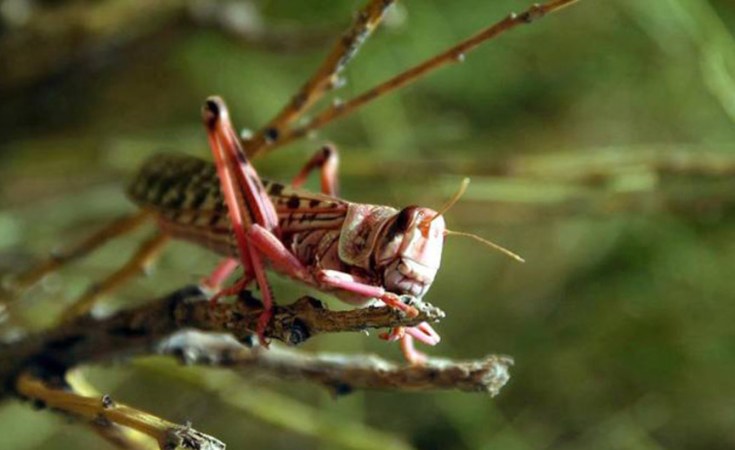Kampala, Uganda — Uganda risks losing up to Shs 800bn (US$218.3 million) in export revenue if the desert locusts are not halted in the coming weeks, according to the agriculture ministry.
East Africa’s third largest economy earns billions of shillings from maize, cotton, coffee, fruits, vegetables and simsim exports. In 2018, Uganda earned US$ 106.8 million in maize exports, followed with cotton (US$ 44.3 million), fruits and vegetables (US$ 40.6 million) and simsim (US$ 26.6 million).
Vincent Ssempijja, the agriculture minister said on Feb.25 that Uganda is at risk of incurring more losses if locusts decimate a dozen crops that are widely grown in the regions so far invaded.
Uganda which had been locust-free for close to 70 years was attacked on Feb. 09 causing both excitement and apprehension among the country’s population. The much anticipated swarms of desert locusts invaded Uganda from neighbouring Kenya through the northeastern district of Amudat in Karamoja sub-region and they have since been sighted in about 20 districts in Teso, Lango, Acholi and Sebei.
These regions are known to be the leading producers of cereals (maize, wheat, barley, sorghum, and millet), root crops (sweet potatoes and cassava), pulses (beans and pigeon peas) and oil crops (soy beans, simsim and sunflower).
Farmers, however, are yet to record major losses since the locusts invaded the country during the offseason. Uganda has two major cropping seasons. The first one begins in March until June and the second one starts in September until December.
However, on Feb. 18, the Mountain Elgon region of Sebei became the latest area to be invaded by the marauding insects. The swarms entered Bukwo District from Kenya’s West Pokot causing panic among farmers in the sub-region as the locusts covered the main crops -coffee trees, pines, cereals and bananas.
The plantations, according to Bukwo Resident District Commissioner, Tom Chesol, could not be reached by the UPDF soldiers since the gardens are perched on cliffs. Flowering coffee trees were badly damaged as the insects descended southwards to Kween District.
Local government officials said although UPDF soldiers who have been spraying the insects from the ground using hand-held pumps responded, it was not easy to fight the locusts because of the challenging mountainous terrain.
While giving an update to the press on Feb. 25, Ssempijja said new swarms of locusts had entered Uganda from Kenya through Nakabat on Feb.24. He said the recent swarms that entered Uganda have laid millions of eggs and the eggs are now hatching. “Uganda is in grave danger of incurring (agricultural) losses,” he said.
The minister said the eggs have also hatched in the Turkana area in northwestern Kenya from where the hoppers migrated to Uganda in early February. This has put Uganda in acute danger, he said.
Ssempijja said the government in collaboration with her partners – FAO and the Desert Locust Control Organization (DLCO) are taking an all-out offensive approach within the Karamoja, Teso, Acholi, and Lango sub-regions to contain the situation.
Ssempijja said the government is moving fast to enhance surveillance by studying the migration patterns and areas where the desert locusts could be laying eggs. Surveillance and GIS teams will continue to work hand in hand with the support of the UPDF in the region to construct maps of sites where the eggs have been laid. This, he said, will enable the technical staff to survey and monitor the hotspots for any locust outbreak.
The minister said the government had also finally received an aircraft from the Desert Locust Control Organization (DLCO) to start aerial spraying of the marauding insects. The surveillance maps will provide coordinates for the aircraft that will be used in the aerial spraying of the nymphs and immature locusts that will be hatched in the region in less than 14 days.
Extreme weather
Experts on locusts say extreme weather patterns in the eastern Africa region have created and sustained the perfect breeding environment for the insects, facilitating rapid swarm growth that the UN’s Food and Agriculture Organization has warned could grow 500 times by June, this year.
According to an update released by FAO on Feb. 24, the situation “remains extremely alarming” in the Horn of Africa, more specifically in Ethiopia, Kenya and Somalia where widespread breeding is in progress and new swarms are expected to form around March.
FAO said swarms of desert locusts which are unrelated to the ones currently wreaking havoc in East Africa had recently made significant movement over the Arabian Peninsula and had reached both sides of the Persian Gulf.
In Saudi Arabia, for instance, ground control operations increased against hopper bands on the Red Sea Coast and immature groups and swarms in the interior. In Yemen, another generation of breeding is in progress on the Red Sea Coast where hatching and early instar hopper bands are forming. Immature and mature swarms arrived in Kuwait, Qatar and along the southwest of Iran on February 20-21.
In eastern Africa, breeding of the locusts continues unabated in Somalia and Ethiopia and this worries Ugandan authorities more. In Kenya, FAO said in its brief that authorities continue to report swarms in northern and the central parts of the country while mature swarms have been sighted around Lake Turkana.
In the DR Congo, a small group of mature desert locust arrived on the western shore of Lake Albert near Bunia on Feb. 21 after crossing northern Uganda, thanks to strong northeasterly winds. The invasion of Congo, FAO said, was the first since 1944. Millions of these are mature and continue to lay eggs. Hatching of the eggs, officials say, will increase the number of hopper bands in the coming weeks causing them to swarm around the region.
Dr. Antonio Querido, the FAO Representative in Uganda earlier told The Independent that as long as Kenya has not brought the infestation under control, swarms may continue to arrive in Uganda.
He told The Independent that only effective surveillance will guide the country to deploy relevant control measures such as aerial spraying.
“It is very important that Uganda keeps an active surveillance system especially in areas where these adult swarms have been,” he said.
“If the swarms present in Uganda find suitable areas for laying eggs, these will hatch into hoppers in about 14 days or months to come depending on how favourable the climatic conditions are. Hopper bands are the most destructive stage of the Desert Locust cycle as they feed on anything green.”
Querido added: “If the locust hoppers are not controlled at the breeding (stage), they will quickly mature into adult hoppers, a stage that feeds unselectively on anything green. Locusts destroy food crops and livestock forage.”
Going forward, Minister Ssempijja said President Museveni has ordered procurement of two aircraft to spray the locusts. Although some government critics have expressed their dissatisfaction at the response from the government, calling it lackluster and haphazard, Ssempijja said he was so far happy with the response from the government and development partners.
He argued that while in Kenya it took weeks for the government to respond to the invasion, in Uganda it took less than 24 hours.
The government mobilized close to Shs 22bn from its treasury and development partners and bought appropriate equipment and pesticides, leased an aircraft to help spray the locusts. However, of the initial Shs 22bn originally earmarked for the desert control, more than half (Shs 11.1bn) went to paying Uganda’s arrears to the Desert Locust Control Organization.
Apparently, Uganda had not paid its membership fees in 40 years. Another Shs 3.6bn was dispatched for hiring the specialized aircraft while Shs 300 million was given to the UPDF operations. Shs 7bn was used to buy pesticides and other logistics. Ssempijja said that his ministry had asked for another Shs 16bn to fight the desert locusts.
“We have asked for Shs 16bn; with Shs 9bn intended for the UPDF officers who are combating the locusts on the ground,” he said, adding that Shs 5.6 million will be used to buy more chemicals.
“We have also found out that we have to engage the local administration units (LCI, LCII, LCIII, LCIV and LCV) and we have budgeted for about Shs 1.2bn for this lower local government which we didn’t think about initially,” Ssempijja added.
ALL AFRICA










